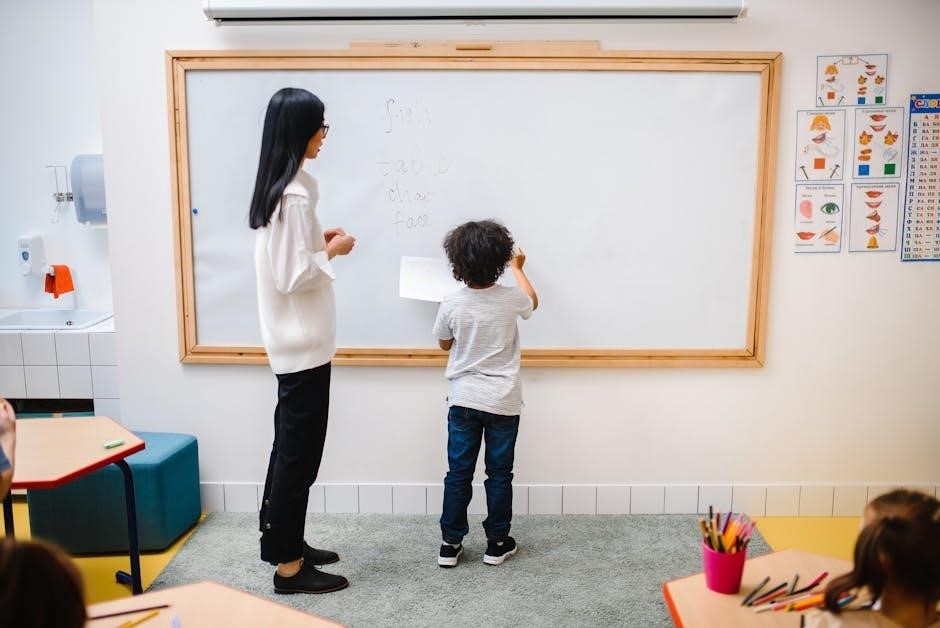Differentiated alphabet knowledge instruction ensures all students grasp foundational literacy skills by tailoring teaching methods to individual needs, learning styles, and prior knowledge, fostering inclusive and effective learning environments.
Defining Differentiated Instruction in the Context of Alphabet Learning
Differentiated instruction in alphabet learning involves tailoring teaching methods to meet the unique needs, skills, and learning styles of individual students. It recognizes that learners vary in prior knowledge, readiness, and engagement levels. By adapting lessons to these differences, educators ensure equitable access to foundational literacy skills. This approach may include varied pacing, personalized activities, and diverse resources to accommodate learners at different stages of alphabet knowledge development. For example, some students may need additional support with letter recognition, while others may require challenges to deepen their understanding. Differentiated instruction emphasizes flexibility, allowing teachers to address gaps and extend learning opportunities, ensuring no student is left behind or unchallenged. This strategy fosters an inclusive and effective learning environment.

Assessing Student Needs for Differentiated Instruction
Assessing student needs involves evaluating prior alphabet knowledge, learning styles, and readiness levels to inform instruction. This ensures targeted support and personalized learning paths for all learners.

Methods for Evaluating Prior Alphabet Knowledge
Evaluating prior alphabet knowledge involves assessing students’ ability to name letters, identify sounds, and recognize shapes. Teachers can use informal assessments like flashcard drills, letter naming tasks, and sound identification games. Digital tools and apps also provide interactive ways to gauge knowledge levels. Observing students during activities helps identify gaps and strengths. Progress monitoring through formative assessments ensures timely interventions. Additionally, reviewing student work samples and conducting one-on-one interviews offers deeper insights. These methods help educators understand each student’s starting point, enabling targeted instruction and personalized learning paths. Accurate assessments are crucial for differentiated instruction, ensuring no student is left behind or bored. This step lays the foundation for effective, tailored teaching strategies.
Instructional Strategies for Differentiated Alphabet Teaching
Differentiated alphabet teaching employs small group instruction, technology integration, and hands-on activities to cater to diverse learning needs, ensuring engagement and tailored progress for all students.

Small Group Instruction for Targeted Learning
Small group instruction is a powerful strategy for differentiated alphabet teaching, allowing teachers to tailor lessons to specific student needs and skill levels. By grouping students with similar abilities or learning goals, educators can deliver targeted instruction that addresses knowledge gaps and accelerates progress. This approach fosters active participation, as students engage in hands-on activities, manipulatives, and guided practice. Research, such as Stahl (2014) and Piasta, highlights that small group instruction is more efficient and effective than whole-class or individual teaching methods. It enables personalized feedback, reinforces learning, and ensures that no student is left behind; This method is particularly effective for introducing new letters, sounds, and shapes, making it a cornerstone of differentiated alphabet instruction;
Integrating Technology for Personalized Learning Paths
Integrating technology into alphabet instruction offers personalized learning paths tailored to individual student needs. AI-powered tools and adaptive software enable real-time assessments, identifying knowledge gaps and adjusting instruction accordingly. Digital platforms provide interactive activities, such as letter recognition games and phonemic awareness exercises, that cater to diverse learning styles. This approach allows teachers to deliver targeted interventions, ensuring each student progresses at their own pace. By leveraging technology, educators can create dynamic, engaging lessons that address the unique requirements of all learners, fostering early literacy skills effectively. This innovative method supports differentiated instruction, making it easier to meet the varied needs of students in a technology-enhanced learning environment.
Hands-On Activities to Engage Diverse Learners
Hands-on activities are essential for engaging diverse learners in alphabet instruction. Manipulatives like letter tiles, sandpaper letters, or magnetic letters allow students to explore letter shapes tactilely, reinforcing letter recognition and sound association. Craft projects, such as tracing letters in play dough or creating foam letter collages, cater to kinesthetic learners. Interactive games, such as matching uppercase and lowercase letters or sorting letters by sound, encourage active participation. These activities accommodate different learning styles, ensuring all students stay engaged. Teachers can adapt these tasks to suit individual or small group needs, making them a versatile tool for differentiated instruction. Hands-on learning fosters a deeper connection to alphabet knowledge, making it fun and accessible for all learners.

Supporting Diverse Learners
Supporting diverse learners involves using scaffolding techniques for those needing extra support and enrichment activities for advanced students, ensuring all learners progress at their own pace effectively.

Scaffolding Techniques for Students Needing Extra Support
Scaffolding techniques provide temporary support to students who need extra help in mastering alphabet knowledge. These strategies include breaking tasks into smaller steps, using visual aids like letter cards or posters, and incorporating hands-on activities such as tracing letters or matching games. For example, using puppets to introduce letters can make learning engaging and accessible for struggling learners. Additionally, providing manipulatives like magnetic letters or letter blocks allows students to explore letter shapes and sounds at their own pace. Teachers can also offer one-on-one support or pair students with peers who can model correct behaviors. By gradually releasing responsibility as students gain confidence, scaffolding ensures they build a strong foundation in alphabet knowledge without feeling overwhelmed.

Enrichment Activities for Advanced Learners
Enrichment activities for advanced learners provide challenges beyond basic alphabet knowledge, ensuring these students stay engaged and continue growing. These activities might include creating stories or art using letters they already know, or exploring advanced literacy skills like word building or basic spelling. Teachers can also integrate technology, such as apps that introduce more complex letter-sound relationships or interactive games that reinforce alphabet mastery. Additionally, encouraging independent projects, like designing alphabet books or teaching letters to peers, fosters leadership and deeper understanding. By offering these opportunities, educators ensure advanced learners remain motivated and continue developing their literacy skills at an appropriate pace.

- Independent letter-based projects
- Digital tools for advanced exploration
- Peer teaching opportunities
Cultural Responsiveness in Alphabet Instruction
Culturally responsive alphabet instruction incorporates diverse texts and resources reflecting students’ backgrounds, ensuring engagement and validation of their experiences. This approach fosters inclusivity and deeper connections to learning.
Incorporating Diverse Texts and Resources
Incorporating diverse texts and resources into alphabet instruction enhances cultural responsiveness and engagement. By using materials that reflect students’ backgrounds and experiences, educators create an inclusive environment. This approach validates students’ identities and fosters deeper connections to learning. Diverse texts, such as multicultural stories and bilingual resources, provide opportunities for students to see themselves represented while mastering alphabet knowledge. Additionally, integrating digital tools and interactive platforms allows for personalized learning paths tailored to individual needs. This strategy ensures that all learners, regardless of their proficiency level or learning style, have access to resources that support their growth. By combining cultural relevance with differentiated instruction, teachers can create a rich and effective learning experience.

Monitoring Progress and Adjusting Instruction
Regularly using formative assessments helps educators identify knowledge gaps, enabling timely interventions. This data-driven approach ensures instruction is adjusted to meet individual needs, optimizing learning outcomes effectively.
Using Formative Assessments to Guide Teaching
Formative assessments are essential for monitoring student progress and guiding instruction in differentiated alphabet knowledge teaching. These assessments, such as quizzes, observations, and digital tools, help identify knowledge gaps early, enabling timely interventions. By regularly evaluating students’ understanding of letter names, sounds, and shapes, educators can adjust lessons to address individual needs. This approach ensures that no student falls behind and allows for personalized learning paths. Incorporating technology, like adaptive learning platforms, further enhances the ability to track progress and tailor instruction. Formative assessments not only improve teaching effectiveness but also empower students to take an active role in their learning journey, fostering a more inclusive and supportive educational environment. This ongoing process ensures that instruction remains aligned with student needs, promoting equitable and impactful learning outcomes.



